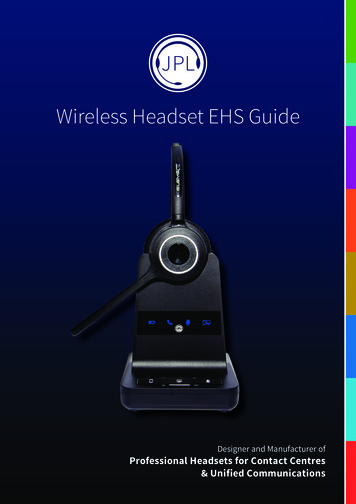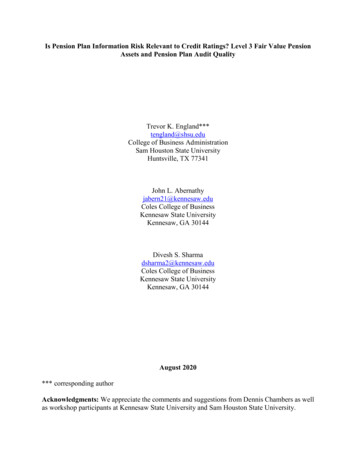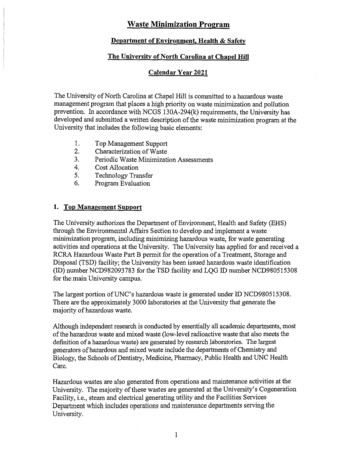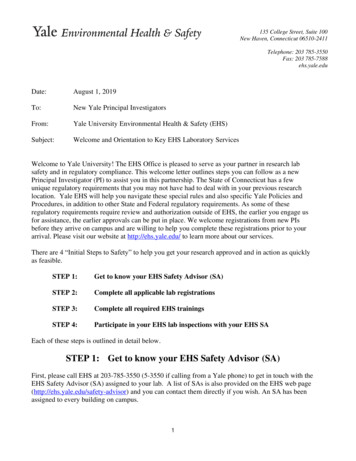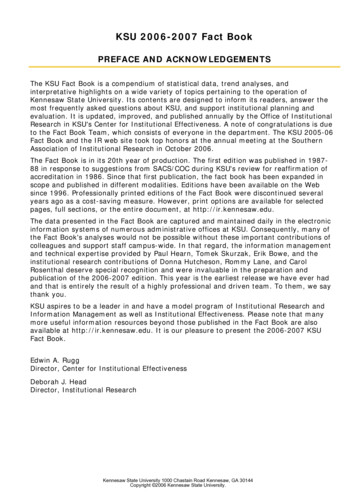
Transcription
Waste Management ProgramEnvironmental Health & SafetyEOSMS– 0001Date: 06/25/2013REV: draft2Page 1 of 61. PurposeNon-hazardous and hazardous chemical wastes, biohazardous wastes, regulated medical wastesand universal wastes generated by KSU will be handled according to the rules and regulations ofthe EPA Resource and Recovery Act (Title 40 Code of Federal Regulations (40CFR), Parts 260268, 273 and Part 279 and Parts 124 or 270). KSU will also comply with the GeorgiaEnvironmental Protection Division (EPD) Rules for Hazardous Waste Management.The purpose of this Program is to provide the procedural framework regarding the handling ofwastes from “cradle to grave”. This includes waste determinations, characterizations, laboratorypractices and proper disposal.2. ScopeThis policy will affect anyone who generates wastes including but not limited to the student in thelaboratory, the Principle Investigator, Faculty and Plant Operations Staff. All wastes will bedisposed of by reputable hazardous or biohazardous waste handlers.The scope of solid waste management covered by this Program includes a variety of materialsincluding non-hazardous waste, hazardous chemical waste, biohazardous waste, regulated medicalwaste and universal waste.KSU is a small quantity generator which is defined as one who generates more than 100 kg (220lbs) but less than 1000 kg (2200 lbs) of hazardous waste and less than 1 kg (2.2 lbs) of acutelyhazardous waste per calendar month.3. ResponsibilitiesEnvironmental Health, Safety and Risk Management Department (EHS&RM) is responsible forproviding guidelines and training, tracking regulatory requirements, ensuring that the followingprocedure accurately reflects current requirements, and auditing program implementation.For the purpose of this procedure, the waste generator is the individual responsible for handling oruse of the material being offered for disposal or removal. This applies to all waste, from simple tocomplex. The person making the initial decision affecting how waste is offered for removal/recyclingis most knowledgeable about the nature of the material. It is the generator's responsibility tounderstand how to properly manage waste.The generator (e.g., Principal Investigator or supervisor) is responsible for determining if a materialis spent or intended for discard, thereby a waste material. The generator must determine if thematerial is a hazardous waste by characteristic or specific constituents. The hazardous wastegenerator is also responsible for recognizing opportunities for waste minimization.EOSMS – Waste Management ProgramPage 1
Waste Management ProgramEnvironmental Health & SafetyEOSMS– 210Date: 06/25/2013REV: draft2Page 2 of 6Plant Operations is responsible for managing nonhazardous solid waste and providing collectiondevices, removal equipment, and trained personnel for managing specific categories of waste.4. ProcedureA.DefinitionsBiohazards are biological agents or substances present in or arising from the work environment.They present or may present a hazard to the health or wellbeing of the worker or thecommunity. Biological agents and substances include infectious and parasitic agents,noninfectious microorganisms, such as fungi, yeasts, algae, plants and plant products, andanimals and animal products that cause Occupational disease. Generally, biohazards areinfectious microorganisms, toxic biological substances, biological allergens or any combinationof those materials.Biological Waste means organic nonpathological waste, including dead animals, animal parts,and tissue.Blood and body fluids means liquid blood, serum, plasma, other blood products,emulsified human tissue, spinal fluids, pleural and peritoneal fluids.Generator is any person whose act or process produces waste. At Kennesaw State University,and for the purpose of this document, this would be the Principal Investigator, LaboratorySupervisor, Manager or other person responsible for a local area in which chemicals are usedor stored. "Generator" will also be used for matters pertaining to the University as a whole.Hazardous waste is any solid waste that is ignitable, corrosive, reactive, or toxic, a listedhazardous material, or contains a listed hazardous material.Medical waste means any solid waste which is generated in the diagnosis, treatment, orimmunization of human beings or animals, in research pertaining thereto, or in the production ortesting of biological materials, but does not include any hazardous waste identified or listedpursuant to this Article, radioactive waste, and household waste as defined in 40 Codes ofFederal Regulations Section 261.4(b)(1) in effect on July 1, 1989, or those substances excludedfrom the definition of solid waste in this section.Microbiological wastes means and includes cultures and stocks of etiologic agents. The termincludes cultures of specimens from medical, pathological, pharmaceutical, research,commercial, and industrial laboratories.Nonregulated Hazardous Waste is any solid waste that is technically not a "hazardous waste",but may pose a significant hazard to human health or the environment, or is unacceptable atlocal solid waste management facilities. Sanitary (municipal) landfills cannot accept liquids orcontained gaseous wastes. Wastewater treatment plants must operate within specific limits fortheir sludge's and treated effluent.EOSMS: 210 – Waste Management ProgramPage 2
Waste Management ProgramEnvironmental Health & SafetyEOSMS– 210Date: 06/25/2013REV: draft2Page 3 of 6Pathogens means organisms that are capable of producing infection or diseases, often found inwaste materials.Pathological wastes means and includes human tissues, organs, body parts, secretions andexcretions, blood and body fluids that are removed during surgery and autopsies; and thecarcasses and body parts of all animals that were exposed to pathogens in research, were usedin the production of biological materials or in the in vivo testing of pharmaceuticals, or that diedof known or suspected infectious disease.Putrescible means solid waste capable of being decomposed by microorganisms with sufficientrapidity as to cause nuisances from odors and gases, such as kitchen wastes, offal andcarcasses.Recovered materials means those materials which have known recycling potential, can befeasibly recycled, and have been diverted or removed from the solid waste stream for sale, use,or reuse by separation, collection, or processing.Recyclable material means those materials which are capable of being recycled and whichwould otherwise be processed or disposed of as solid waste.Regulated medical waste means blood and body fluids in individual containers in volumesgreater than 20 ml, microbiological waste, and pathological waste that have not been treatedpursuant to 39134.15 (6) of the Georgia Environmental Protection Division Solid WasteManagement Rules.Resource recovery means the process of obtaining material or energy resources from discardedsolid waste which no longer has any useful life in its present form and preparing the solid forrecycling.Sharps means and includes needles, syringes, and scalpel blades.Solid waste means any hazardous or nonhazardous garbage, refuse or sludge from a wastetreatment plant, water supply treatment plant or air pollution control facility, domestic sewageand sludge's generated by the treatment thereof in sanitary sewage collection, treatment anddisposal systems, and other material that is either discarded or is being accumulated, stored ortreated prior to being discarded, or has served its original intended use and is generallydiscarded, including solid, liquid, semisolid or contained gaseous material resulting fromindustrial, institutional, commercial and agricultural operations, and from community activities.Solid waste does not include recovered materials; solid or dissolved materials in domesticsewage; solid or dissolved materials in irrigation return flows or industrial discharges that arepoint sources subject to permit under 33 U.S.C. Section 1342; or source, special nuclear, or byproduct material as defined by the federal Atomic Energy Act of 1954, as amended (68 Stat.923).EOSMS: 210 – Waste Management ProgramPage 3
Waste Management ProgramEnvironmental Health & SafetyEOSMS– 210Date: 06/25/2013REV: draft2Page 4 of 6Special wastes mean solid wastes that can require special handling and management, includingwhite goods, whole tires, used oil, lead acid batteries, and medical wastes.White goods includes refrigerators, ranges, water heaters, freezers, unit air conditioners,washing machines, dishwashers, clothes dryers, and other similar domestic and commerciallarge appliances.Used oil means any oil which has been refined from crude oil or synthetic oil and, as a result ofuse, storage, or handling, has become unsuitable for its original purpose due to the presence ofimpurities or loss of original properties, but which may be suitable for further use and iseconomically recyclable.Universal Waste is a broad term the Environmental Protection Agency uses to identify certainwidely generated wastes. The Universal Waste regulations have streamlined hazardous wastemanagement standards for the federal universal wastes (batteries, pesticides, thermostats, andlamps). The regulations govern the collection and management of these widely generatedwastes. This facilitates the environmentally sound collection and increases the proper recyclingor treatment of the universal wastes mentioned above.B.Chemical WastesBefore beginning a project, it is the responsibility of the waste generator to minimize waste bydetermining the hazards associated with the chemical/product and choosing thechemical/product of lesser hazard. PIs and Supervisors should order and store minimumamounts of hazardous chemicals and products. Be aware that certain chemicals are difficultand costly to dispose of. Some examples follow:1)Heavy metals such as mercury, barium, cadmium, chromium, beryllium, silver,selenium, and tellurium.2)Chlorophenols, dioxins, and cyanides.3)Compressed gases including lecture bottles or containers with liquids underpressure. Arrange with the supplier to return empty or unused containers.4)Manufacturer’s samples. Either arrange for the manufacturer to accept return ofunused products or provide an MSDS or product data sheet with a description ofthe product and its characteristics.Satellite accumulation areas may be established at or near the point of generation of the wastewhere up to 55 gallons of hazardous waste or 1 quart of acutely hazardous waste can bestored. If the stored wastes exceed these limits, the waste must be moved to a 180-day storagearea within 3 days. This area must be one in which spills can be contained. A sink or an openarea outside is not acceptable as an accumulation area.Waste containers must be labeled with the words “hazardous waste” or “non-hazardous waste”and the contents of the waste container. A log sheet beside the container is the recommendedEOSMS: 210 – Waste Management ProgramPage 4
Waste Management ProgramEnvironmental Health & SafetyEOSMS– 210Date: 06/25/2013REV: draft2Page 5 of 6way of tracking what is placed in the waste container. EHS&RM along with the chemical wastecontractor will characterize the waste based on the contents. If containers are too small to holda label, they should be placed in secondary containment and that should be labeled.The waste containers must be closed unless waste is being placed in the container. Funnelswith positive latch lids are available for purchase and should be used when necessary.Once the container is full, a waste card should be created in Chematix and the waste submittedfor pick-up by EHS&RM. The start accumulation date is the date when the container is full, notthe date when the first waste is placed in the container.At no time is chemical waste to be placed in the sanitary sewer.PIs and Supervisors will review their chemical inventories twice a year and dispose of out-datedand unnecessary chemicals. Special attention should be given to peroxide formers and otherpotentially explosive chemicals. These chemicals should not be kept past the manufacturers’expiration date.C.Biological WasteBiological waste must be placed in red biohazard bags (decanted, if necessary). After tying thebag, place it in a cardboard box provided by EHS&RM. The box should be preparedbeforehand by taping the bottom of the box in two directions (shipping tape creating a bottomthat is solid tape). The box with the contents must be weighed and cannot exceed 45 lbs. A“pathological only” sticker will be placed on the box.Once the box is ready, create a waste card in Chematix identifying the waste as regulatedmedical waste, pathological only. Submit to EHS&RM for pick-up.D.Regulated Medical WasteRegulated medical waste must be placed in a red biohazard bag and placed inside thebiohazard labeled cardboard box. The boxes and bags will be provided by EHS&RM. Sharpsare to be collected in rigid sharps containers. Once full, the container should be closed andplaced in a red bag which is then placed inside the box. When the box is full, a waste cardshould be created in Chematix stating either regulated medical waste with or without sharps.Submit a pick-up request to EHS&RM.E.Universal WasteUniversal waste includes fluorescent tubes, high intensity discharge bulbs (HID), compactfluorescent bulbs (CFB), batteries, pesticides and thermostats.All fluorescent tubes, HID and CF bulbs must be placed in sturdy containers that will protectthem from breaking. The original box that held the bulbs is the best container to use. Whenthat is not available, fiber or poly drums will be provided. The bulbs must be placed inside theEOSMS: 210 – Waste Management ProgramPage 5
Waste Management ProgramEnvironmental Health & SafetyEOSMS– 210Date: 06/25/2013REV: draft2Page 6 of 6containers and the top must be placed on the containers. Bulbs may be stored in closets in thismanner until they are collected and placed in the central collection area.Batteries will be collected in a central location and recycled by a battery recycling company.Pesticides disposal will be coordinated with the chemical waste contractor.Thermostats containing hazardous materials will also be disposed of through the chemicalwaste contractor.EOSMS: 210 – Waste Management ProgramPage 6
including non-hazardous waste, hazardous chemical waste, biohazardous waste, regulated medical waste and universal waste. KSU is a small quantity generator which is defined as one who generates more than 100 kg (220 lbs) but less than 1000 kg (2200 lbs) of hazardous waste and less than 1 kg (2.2 lbs) of acutely hazardous waste per calendar .
